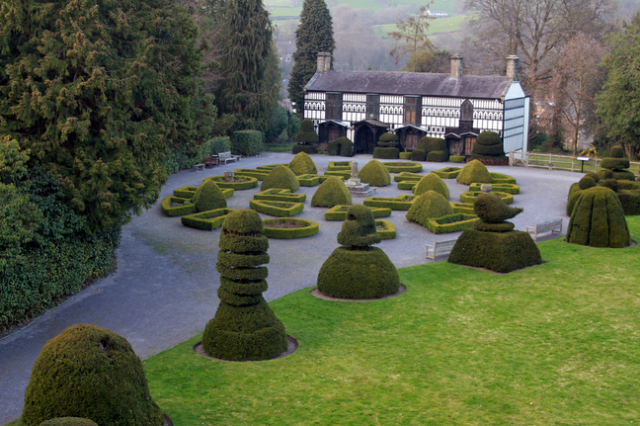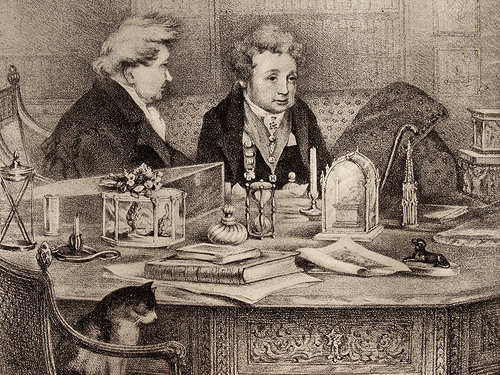
June is LGBT Pride Month, so we’re celebrating all of our pride by feeding babies to lions! Just kidding, we’re talking about lesbian history, loosely defined as anything that happened in the 20th century or earlier, ’cause shit changes fast in these parts. We’re calling it The Way We Were, and we think you’re gonna like it. For a full index of all “The Way We Were” posts, click that graphic to the right there.
Previously:
1. Call For Submissions, by The Editors
2. Portraits of Lesbian Writers, 1987-1989, by Riese
3. The Way We Were Spotlight: Vita Sackville-West, by Sawyer
4. The Unaccountable Life of Charlie Brown, by Jemima
5. Read a F*cking Book: “Odd Girls & Twilight Lovers: A History of Lesbian Life in 20th-Century America”, by Riese
6. Before “The L Word,” There Was Lesbian Pulp Fiction, by Brittani
7. 20 Lesbian Slang Terms You’ve Never Heard Before, by Riese
8. Grrls Grrls Grrls: What I Learned From Riot, by Katrina
9. In 1973, Pamela Learned That Posing in Drag With A Topless Woman Is Forever, by Gabrielle
10. 16 Vintage “Gay” Advertisements That Are Funny Now That “Gay” Means “GAY”, by Tinkerbell
11. Trials and Titillation in Toronto: A Virtual Tour of the Canadian Lesbian & Gay Archives, by Chandra
12. Ann Bannon, Queen of Lesbian Pulp Fiction: The Autostraddle Interview, by Carolyn
13. 15 Ways To Spot a Lesbian According To Some Very Old Medical Journals, by Tinkerbell
14. The Very Lesbian Life of Miss Anne Lister, by Laura L
15. The Lesbian Herstory Archives: A Constant Affirmation That You Exist, by Vanessa
16. I Saw The Sign: Queer Symbols Then and Now, by Keena
17. The Ladies Of Llangollen: Runaway Romantics In 18th Century Ireland, by Una
![]()
 In 18th century, an affair scandalised Ireland. Eleanor Butler was the daughter of the most powerful family in the country, the Butlers of Kilkenny Castle, one of the finest (still standing) castles in the country. Sarah Ponsonby was an orphan 16 years younger than her who was attending a nearby girl’s school. They became friends, and then hooked up. Too bad that wasn’t an option in the society and time they were living in. But they were determined to be with each other, and the only way that could happen was by getting the hell out of Dodge.
In 18th century, an affair scandalised Ireland. Eleanor Butler was the daughter of the most powerful family in the country, the Butlers of Kilkenny Castle, one of the finest (still standing) castles in the country. Sarah Ponsonby was an orphan 16 years younger than her who was attending a nearby girl’s school. They became friends, and then hooked up. Too bad that wasn’t an option in the society and time they were living in. But they were determined to be with each other, and the only way that could happen was by getting the hell out of Dodge.
After their first escape failed, Eleanor and Sarah were sent to separate houses. By then, Eleanor’s family said she “had a debauched mind” (party on) and Sarah said she “wanted to live and die with Eleanor Butler”. Such statements meant that their relationship was being increasingly examined.

If you a picture a society that was beyond uptight, ruled by convention, class, religion and stifling familial duties and a strictly determined destiny amongst the castle-dwelling aristocracy, the idea that these two women would be in love with each other, never mind being involved in a sexual relationship was beyond comprehension.
At that time in Ireland, letter writing was the only form of communication with mail deliveries happening multiple times between houses and castles every day. Many of these letters between Eleanor and Sarah themselves and their surrounding guardians remain, illustrating the confused concerns their families had and indeed their love for each other. Two women of their class would have to marry men and carry on the lineage of Anglo-Irish aristocracy. They had no other option but to try to escape again. This time, they succeeded. Eleanor left her sister’s house in the middle of the night and walked 12 miles to Sarah, with the assistance of her servant Mary.
They crossed the Irish Sea to Wales, and came upon a stone house in Llangollen. They developed ‘The System’, a system that meant they would turn their backs on traditional society, rarely leave home, develop a sustainable way of living through self-sufficiency, growing their own vegetables and fruit and building a dairy, as well as giving 10% of their income to charity. Essentially, they were embarking on a queer DIY lifestyle.

They refurbished their house in gothic style, with intricate carvings and other cool stuff. Eventually, they got a name for being awesome and visiting writers such as William Wordsworth, Percy Shelley and Lord Byron came to hang out. They became The Ladies Of Llangollen.

They died within two years of each other in 1829 and 1832.
This radio documentary by Irish national radio station RTE illustrates their amazing story with brilliant sensitivity. Listen to An Extraordinary Affiar.







